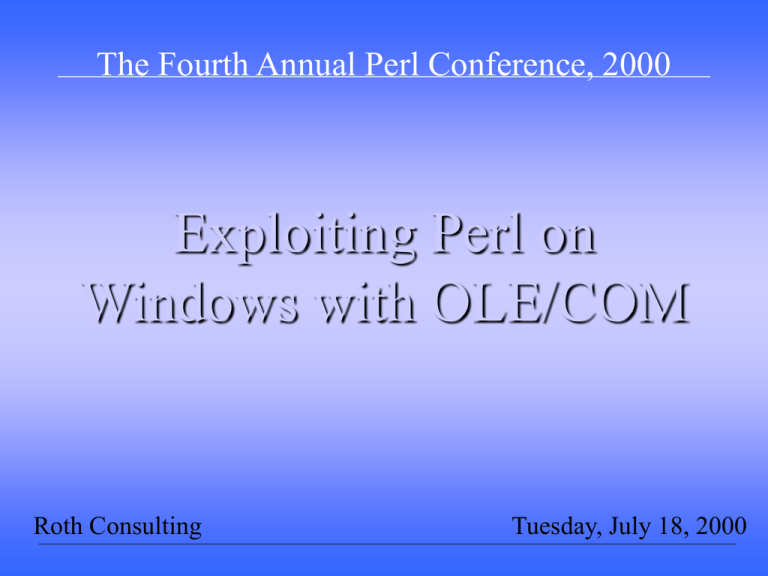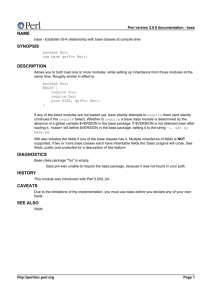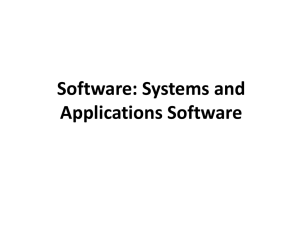Exploiting Perl on Windows with OLE/COM
advertisement

The Fourth Annual Perl Conference, 2000
Exploiting Perl on
Windows with OLE/COM
Roth Consulting
Tuesday, July 18, 2000
OLE: Object Linking and
Embedding
• OLE is just the
technology
which allows an
object (such as a
spreadsheet) to
be embedded
(and linked)
inside of another
document (a
word processor
document).
Roth Consulting
Exploiting Perl on Windows with OLE/COM
2
OLE: Object Linking and
Embedding II
• Version 1 used DDE to communicate between
applications.
• Version 2 uses COM instead of DDE (although
DDE still exists for legacy reasons)
• Perl focuses more on COM than OLE.
Roth Consulting
Exploiting Perl on Windows with OLE/COM
3
COM: Component Object Model
• Microsoft technology.
• Compare to CORBA
• COM is the protocol which allows OLE to work
• Rules of the road for programs to talk with each other
• Foundation of automation
• Permits non-related software components to work
together
Roth Consulting
Exploiting Perl on Windows with OLE/COM
4
What is Automation?
• Automation is the ability to control an application
from another process.
• Sometimes referred to as scripting.
• For example, Perl script starts Excel, loads
spreadsheet, adds data, saves, quits Excel.
• Perl (and PerlScript) can make use of automation.
• Visual Basic for Applications (VBA) is a scripting
language which makes use of automation.
• Windows Shell Host permits automation
Roth Consulting
Exploiting Perl on Windows with OLE/COM
5
Windows Shell Scripting
• Referred to as WSH (pronounced as wish)
• Comes with Windows 2000 and Windows ME
• Allows plug-able shells such as PerlScript, VB,
JavaScript
Roth Consulting
Exploiting Perl on Windows with OLE/COM
6
COM vs. OLE: A Fair Fight?
• They are totally different from each other
• OLE is like the ability to embed a letter within an
envelope
• COM is like how to fold the letter, what size the
envelope must be to fit the letter and other rules
such as where to put the stamp and address on the
letter (then where to take the letter)
• The Win32::OLE extension could (and maybe
should) have been called Win32::COM
• Users may have confused it for an extension that
manages serial ports
Roth Consulting
Exploiting Perl on Windows with OLE/COM
7
COM terms to know
• COM object: A chunk of memory which
represents a particular COM interface
• COM collection: A group of similar COM objects
• controller process: Process or application which
will play with COM objects. This process
“controls” a COM server
• interface: Specific API that is built into a COM
object
• automation: Ability to control COM objects
without having to know how the COM object was
designed
Roth Consulting
Exploiting Perl on Windows with OLE/COM
8
COM terms to know II
• object model: The blueprints for a COM object
• COM server: The component that generates COM
objects
• in-proc: In process; this COM server is typically a DLL
that the controller process loads into it’s own memory
space
• out-of-proc: Out of process; this COM server is a
process separate from the controlling process. Could
even be running on another machine
Roth Consulting
Exploiting Perl on Windows with OLE/COM
9
COM Objects
• A COM object is a set of functions and data
• Functions
• Called methods
• Perform an action
• Returns a result such as an numeric value, a string and array or
another COM object
• Example
• Print()
• GetAddress()
Roth Consulting
Exploiting Perl on Windows with OLE/COM
10
COM Objects II
• Data
• Called properties
• Some properties are read/write so they can be both set
and queried
• Some properties are read-only so they can only be
queried
• Properties are really functions that are called
get_PropertyName()/set_PropertyName()
• Properties can be a numeric value, a string, an array or
another COM object
• Common example
• Count
• CurrentDate
• Font
Roth Consulting
Exploiting Perl on Windows with OLE/COM
11
COM Collection Object
• Special type of COM object which represents a
bunch of other COM objects
• COM Collection object is similar to a Perl array
which contains a list of COM objects
• A collection object typically has a name which is
the plural of the type of COM object it represents
• Fonts would represent a collection of Font COM
objects
• Documents would represent a collection of Document
COM objects
Roth Consulting
Exploiting Perl on Windows with OLE/COM
12
What is an Object Model?
• Consider an object model to be the blueprint for
the way an object oriented class works
• Just as a car manufacture creates a model of a car
before designing it so does the author of a COM object
• The object model literally models the methods
(functions) and members (variables) that a COM object
has
• An object model defines a set of functions (methods)
and variables (members or properties)
• Each set of functions are grouped together and is
called an Interface
• Interfaces are API’s
• API => Application Programming Interface
Roth Consulting
Exploiting Perl on Windows with OLE/COM
13
What is an Object Model II ?
• It’s the infrastructure, silly!
• All Active-X and OLE controls have such
blueprints (or object models)
• The object model describes how another program
can interact with a COM server.
Roth Consulting
Exploiting Perl on Windows with OLE/COM
14
Interfaces, interfaces, interfaces!
• COM defines interfaces into a program.
• Each interface has an unique interface id (IID) to
identify it from other interfaces:
• {000209FF-0000-0000-C000-000000000046}
• Aka GUID, CLSID, UUID, ProgID
• Stored in Registry: HKEY_CLASSES_ROOT\CLSID
• In theory an IID is so unique that no two interfaces
will ever have the same ID; regardless of vendor,
program or platform.
Roth Consulting
Exploiting Perl on Windows with OLE/COM
15
Interfaces, interfaces, interfaces II
• Each interface can have a class name in addition to
an IID:
• “Word.Application”
• “Word.Document”
• Stored in Registry: HKEY_CLASSES_ROOT
Roth Consulting
Exploiting Perl on Windows with OLE/COM
16
COM’s Affair With The Registry
• All COM interface info is stored in the Registry
• Example (MS Word 2000):
• HKEY_CLASSES_ROOT\Word.Application\CLSID
Default = {000209FF-0000-0000-C000000000000046}
• HKEY_CLASSES_ROOT\CLSID\{000209FF-00000000-C000-000000000046}
Roth Consulting
Exploiting Perl on Windows with OLE/COM
17
Threading Models
• Single Threading Model
• Introduced in Win 16 (Windows 3.1) which did not
support threads.
• In NT 3.1 all COM interaction could only take place
from one thread in a process.
• Apartment Threading Model
•
•
•
•
AKA Single-Threaded Apartment Model (STA)
Supported by NT 3.5 and Windows 95.
Any thread could interact with COM objects.
A thread can only interact with COM objects created by
the same thread.
• Currently most common model.
Roth Consulting
Exploiting Perl on Windows with OLE/COM
18
Threading Models II
• Free Threading Model
• AKA Multi-Threaded Apartment Model (MTA)
• NT 4.0, Windows 95 with DCOM service pack
(installed with IE 4).
• Any thread can interact with any COM object
regardless of what thread created it.
Roth Consulting
Exploiting Perl on Windows with OLE/COM
19
Threading Models III
• Neither client nor server needs to be aware of the
other’s threading model (usually).
• COM performs any necessary translations
between clients and servers of different threading
models.
Roth Consulting
Exploiting Perl on Windows with OLE/COM
20
Declaring A Threading Model
• By default Win32::OLE uses the free-threaded
(multi-thread apartment) model.
• You can force Perl to use a particular threading
model using the Win32::OLE->Initialize()
function.
• Must be called before any COM object is created.
• Pass in one of the following values:
• COINIT_APARTMENTTHREADED
• Single threaded model
• COINIT_OLEINITIALIZE
• Single threaded model plus. Some COM servers that utilize
specialized subsystems, such as Events, may require this.
• COINIT_MULTITHREADED
• Multi thread model (the default value)
Roth Consulting
Exploiting Perl on Windows with OLE/COM
21
Declaring A Threading Model II
• Win32::OLE’s single threaded models create a
hidden COM window with a message loop.
• The message loop must be “spun” every so often.
• Spin the message loop by calling:
• Win32::OLE->SpinMessageLoop()
• Failure to spin message loop may cause other processes
to “pause” until another Win32::OLE call is made.
• Some COM servers are more efficient if called
using a particular threading model.
• Events require a single threading model.
Roth Consulting
Exploiting Perl on Windows with OLE/COM
22
Events
• Events are experimental and require that the Perl
script run as in the single threaded apartment
model.
• This can be done by specifying the EVENTS import:
use Win32::OLE qw( EVENTS );
• Events allow a COM object to callback into the
Perl script when an event is fired.
• Register the events of a COM object with the
WithEvents() function:
• Win32::OLE->WithEvents( $ComObj [, Handler [,
Interface]] );
Roth Consulting
Exploiting Perl on Windows with OLE/COM
23
Events II
• The first parameter is a COM object that you want
to monitor events for.
• Second parameter is the event handler. This can
either be a code reference or the name of a Perl
module.
• Code Reference: This code will be called each time an
event is fired.
• Module Name: A function by the same name of the
event will be called in the specified module. If the
function does not exist then the event is ignored.
Roth Consulting
Exploiting Perl on Windows with OLE/COM
24
Events III
• Win32::OLE attempts to register itself with the
default event interface for the specified COM
object.
• If the default event interface can not be
determined then you must specify one as a string
(the third parameter).
• Example:
Win32::OLE->WithEvents( $ComObj,
\&MyEventHandler, ‘IMyEventInterfaceName’ );
This will cause all events from the
IMyEventInterfaceName to call the MyEventHandler
Perl subroutine.
Roth Consulting
Exploiting Perl on Windows with OLE/COM
25
Events IV
• Example 2:
Win32::OLE->WithEvents( $ComObj, \&Events );
sub Events
{
my( $Obj, $EventName, @Args ) = @_;
print “Event $EventName occurred\n”;
}
• All parameters passed into the subroutine that are
references are passed in as variants. You must use
the Put() method to change the value. This is
discussed later in the Variants section.
Roth Consulting
Exploiting Perl on Windows with OLE/COM
26
Events V
• To disable events simply pass in the name of the
object you desire to stop event processing:
• Win32::OLE->WithEvents( $ComObj );
Roth Consulting
Exploiting Perl on Windows with OLE/COM
27
General model of use
• Basically there is a general model of use:
1) A typical controller process will request that a COM
server generate a COM object.
2) The server is loaded or located, the request is
submitted, a response is returned.
3) If request results in a valid COM object then controller
process interacts with the object.
4) Destroy COM object.
Roth Consulting
Exploiting Perl on Windows with OLE/COM
28
What does all this mean?
Let’s say we need to change the title and subject of a
Microsoft Word document
1) Need to somehow run
Word
2) Need to load up the
document
3) Need to change the
title and subject
4) Need to save the
document
5) Need to quit Word
Roth Consulting
Exploiting Perl on Windows with OLE/COM
29
What does all this mean II ?
• How would we implement such a system?
1) Request a Word application COM object
2) Call a function in the Word application COM object
which loads a document. It returns a Word document
COM object
3) Modify the Title and Subject properties from the Word
document COM object
4) Call into the Word document COM object to save to
disk
5) Destroy both the document and application COM
objects
Roth Consulting
Exploiting Perl on Windows with OLE/COM
30
Using Win32::OLE
To use the Win32::OLE extension (thus be able to
manipulate COM objects) you must first load the
extension:
use Win32::OLE;
Roth Consulting
Exploiting Perl on Windows with OLE/COM
31
Procuring a COM object
• Request a new COM object
$Obj = new Win32::OLE( “Word.Application” );
$Obj = Win32::OLE->new( “Word.Application” );
• Optional Second parameter is function to call
when terminating the object
• Some COM servers do not clean up after themselves
such as Excel so you can pass in a second parameter
which specifies a function to call when the object is
destroyed
$Obj = Win32::OLE->new( “Excel.Application”,
\&TerminateExcelApp );
• Can be a string representing a method to call from
within the COM object such as “Quit”
Roth Consulting
Exploiting Perl on Windows with OLE/COM
32
Procuring a COM object II
• Requesting a COM object from a remote machine
via DCOM
• You must replace the first parameter with an
anonymous array consisting of (in order):
• The remote machine
• The class of the COM object to be procured
$Obj = Win32::OLE->new( [ “my.machine.com”,
“Excel.Application” ],
\&TerminateExcelApp );
Roth Consulting
Exploiting Perl on Windows with OLE/COM
33
Procuring a COM object III
• Request a COM object from the pool of already
existing objects.
• Usually works with non in-proc COM servers
• Minimizes memory and processor overhead
$Obj = Win32::OLE->GetActiveObject(
“Word.Application” );
• Fails if the object does not already exist in memory
Roth Consulting
Exploiting Perl on Windows with OLE/COM
34
Procuring a COM object IV
• Request a COM object from a file (aka a
persistent COM object):
$Obj = Win32::OLE->GetObject( ‘c:\mystuff.doc’ );
• Fails if:
•
•
•
•
•
file does not exist
unable to determine the file type
the application is not registered with the Registry
the application is not installed
something else goes drastically wrong
Roth Consulting
Exploiting Perl on Windows with OLE/COM
35
Procuring a COM object V
• Some COM objects can not have multiple
instances of itself therefore you need to use the
GetActiveObject() function.
• Many services such as IIS behave this way:
$IIS = Win32::OLE->GetActiveObject(
“IIS://localhost/” );
• Other COM objects that are allowed multiple
instances (Excel, Word, Netscape, IE, etc) can be
obtained via GetActiveObject() to conserve
memory/processor overhead
Roth Consulting
Exploiting Perl on Windows with OLE/COM
36
Procuring a COM object VI
A Trick:
• If you use GetActiveObject() to conserve
memory and the COM object can have multiple
instances then upon the function failing you could
request a new instance of the COM object:
my $Obj;
my $Class = “Word.Application”;
if( ! $Obj = Win32::OLE->GetActiveObject( $Class ) )
{
$Obj = Win32::OLE->new( $Class ) ||
die “Can not obtain a $Class object\n”;
}
Roth Consulting
Exploiting Perl on Windows with OLE/COM
37
Persistent Objects
• Many COM objects can save their state to a
storage device. This is also known as
serialization.
• Persistent COM objects can be loaded back into
memory. A process can then continue using the
COM object.
• The equivalent to using File/Open.
Roth Consulting
Exploiting Perl on Windows with OLE/COM
38
Persistent Objects II
• Examples:
• Word documents can save to DOC file. This is how a
Word document COM object serializes.
• A Photoshop COM object can export itself to a TIFF or
GIF file. This is not serialization since reloading such a
graphic file does not reconstitute the state of the
Photoshop COM object. Saving the COM object as a
.PSD file is serialization.
Roth Consulting
Exploiting Perl on Windows with OLE/COM
39
Persistent Objects III
•
Persistent COM objects loaded using the
GetObject() function.
$Obj = Win32::OLE->GetObject( "c:\\temp\\foo.doc" );
•
•
Any COM object can be loaded in this way as
long as an entry exists for it in the Registry.
COM tries to resolve the class of the persistent
object.
1)
2)
3)
4)
Roth Consulting
Check current COM objects in memory for the object
Check the file’s classid (only in structured docs)
Compare registered document masks with file
Compare file extension with registered extensions
Exploiting Perl on Windows with OLE/COM
40
Querying a COM object’s type
At this point we have a Word Application COM
object (or we died and terminated the script)...
• We can make sure the object is indeed a Word
Application object with the
Win32::OLE->QueryObjectType( $Obj );
• The function will return a text string representing
the type of object: “Word_Application”
• Usually this is only needed on objects that of an
unknown type
• If a function returns an unknown COM object use
QueryObjectType()to determine its type
Roth Consulting
Exploiting Perl on Windows with OLE/COM
41
COM Object properties
We can now mess around with the Word document
COM objects properties...
• One of a Word application COM objects many
properties is the Visible property. This renders the
Word application either visible or invisible to the
user (by default it is invisible):
$Word->{Visible} = 1;
• Another property is a collection of documents that
Word currently has open:
$Docs = $Word->{Documents};
Roth Consulting
Exploiting Perl on Windows with OLE/COM
42
COM Object properties II
• Properties are really functions. Thus the following
are equivalent:
$Obj->{Visible};
$Obj->Visible();
• Likewise to set a property, the following are
equivalent:
$Obj->{Visible} = 1;
$Obj->Visible( 1 );
Roth Consulting
Exploiting Perl on Windows with OLE/COM
43
COM Object properties III
• Some properties are COM objects or COM
collection objects:
$Docs = $Obj->{Documents};
$Doc1 = $Docs->Item( 1 );
print $Doc1->{Path};
• You can call a default method indirectly by
passing in parameters. The above is equivalent to :
$Doc1 = $Obj->Documents( 1 );
print $Doc1->{Path};
• NOTE: This makes the Documents property
appear as a method, but it is only a property!
Roth Consulting
Exploiting Perl on Windows with OLE/COM
44
Calling COM object methods
In our Word example we have a COM object
which represents the Microsoft Word program.
Now we need to load a document
• The Word application COM object has an
Open() method which will open and load a Word
document
• The method returns a Word document COM object
• Method calls are made just like a call into a Perl
object:
$Doc = $Obj->Open( ‘c:\temp\myfile.doc’ );
Roth Consulting
Exploiting Perl on Windows with OLE/COM
45
Calling COM object methods II
• Some methods have optional parameters. This can
pose a problem if you need to only specify some
of them
• Open() has the following syntax:
Document* Open(
FileName,
[optional] ConfirmConversions,
[optional] ReadOnly,
[optional] AddToRecentFiles,
[optional] PasswordDocument,
[optional] PasswordTemplate,
[optional] Revert,
[optional] WritePasswordDocument,
[optional] WritePasswordTemplate,
[optional] Format );
Roth Consulting
Exploiting Perl on Windows with OLE/COM
46
Calling COM object methods III
• With optional parameters you can specify them by
name, in any order
• All required parameters must be placed first and in
order
• After the required parameters place all named
parameters and values in an anonymous hash
$Doc = $Word->Open( "c:\\temp\myfile.doc",
{
ReadOnly = > 1,
AddToRecentFiles => 2
} );
Roth Consulting
Exploiting Perl on Windows with OLE/COM
47
Chaining property and methods
• You can chain multiple method calls into one line:
$Path = $Word->{Documents}->Item( 1 )->{Path};
Becomes
$Path = $Word->Documents( 1 )->{Path};
Roth Consulting
Exploiting Perl on Windows with OLE/COM
48
Parameter placeholders
• To skip a parameter in a method use undef
$Obj->Blah( $Param1, undef, $Param2 );
Roth Consulting
Exploiting Perl on Windows with OLE/COM
49
Destroying COM objects
• When finished with a COM object it is best to
destroy it using undef:
undef $Doc;
undef $Word;
• Calling DESTROY() method:
$Obj->DESTROY();
• When the COM object falls out of scope it will
automatically be destroyed:
sub Foo
{
my $Obj = Win32::OLE->new( $Class );
$Obj->Blah();
}
Roth Consulting
Exploiting Perl on Windows with OLE/COM
50
Constants
• Most programs have constant values
• To access constant values you need to load a Type
Library.
• Use Win32::OLE::Const module.
Roth Consulting
Exploiting Perl on Windows with OLE/COM
51
Type Libraries
Q: So how does a program know what interfaces and
constants a particular COM server supports?
A: By means of a type library.
• Type libraries are binary files that describe features
about an interface
•
•
•
•
Properties
Methods
Constants
Help strings (occasionally)
• Typically found in .exe, .dll and .tlb files
Roth Consulting
Exploiting Perl on Windows with OLE/COM
52
Type Libraries II
• Usually have a name associated with them in the
Registry.
• Use OleView.exe to see what type libraries are
registered.
• You can load a type library into Perl’s namespace
using Win32::OLE::Const.
• Loads and exposes all constants for the type library.
• Library names are usually not obvious
• Word 2000 “Microsoft Word 9.0 Object Library”
• Photoshop 4.0 “Photoshop 4.0 Object Library”
• CDO “Microsoft CDO for NTS 1.2 Library”
Roth Consulting
Exploiting Perl on Windows with OLE/COM
53
Type Libraries III
• Loading at compile time:
use Win32::OLE::Const “Some Library Name”;
• Example:
use Win32::OLE::Const “Microsoft Word 9.0 Object
Library”;
print "The Word constant wdSaveChanges is: " .
wdSaveChanges . "\n";
• Loading at run time I. Specifying a library name:
use Win32::OLE::Const;
$LibName = "Microsoft Word 9.0 Object
Library";
$Const = Win32::OLE::Const->Load($LibName);
print "The Word constant wdSaveChanges is: " .
$Const->{wdSaveChanges} . "\n";
Roth Consulting
Exploiting Perl on Windows with OLE/COM
54
Type Libraries IV
• Loading at run time II. Specifying a COM object:
use Win32::OLE::Const;
$File = "c:\\temp\\Foo.doc";
$Doc = Win32::OLE->GetObject( $File );
$Const = Win32::OLE::Const->Load( $Doc );
print "The Word constant wdSaveChanges is: " .
$Const->{wdSaveChanges} . "\n";
Roth Consulting
Exploiting Perl on Windows with OLE/COM
55
Type Libraries V
Both the use and the Load options can take three
other parameters
• Major version (only load if version major matches)
• Minor version (only load if version minor >=)
• Language (Language ID; requires Win32::OLE::NLS)
Roth Consulting
Exploiting Perl on Windows with OLE/COM
56
Collection Properties
• Elements in a COM Collection object can be
enumerated with the Perl keys function:
foreach keys( %$Word )
{
print “$Word->{$_}\n”;
}
• Returns the names of properties
Roth Consulting
Exploiting Perl on Windows with OLE/COM
57
With and In
• Win32::OLE allows for the use of the Visual Basic
with and in commands
• When loading the extension you must export the
keywords:
use Win32::OLE ‘in’;
use Win32::OLE ‘with’;
use Win32::OLE qw( in with );
Roth Consulting
Exploiting Perl on Windows with OLE/COM
58
With and In : with
• Allows for the setting of multiple properties on
one object hence simplifies your code
• Syntax: with( $Obj,
Property1 => Value1,
Property2 => Value2,
Propertyn => Valuen )
$Doc->{BuiltinDocumentProperties}->{Title} = “My Title”;
$Doc->{BuiltinDocumentProperties}->{Author} = “My Name”;
$Doc->{BuiltinDocumentProperties}->{Subject} = “My Subject”;
becomes
with( $Doc->{BuiltinDocumentProperties},
Title => “My Title”,
Author => “My Name”,
Subject => “My Subject” );
Roth Consulting
Exploiting Perl on Windows with OLE/COM
59
With and In : in
• Works only on COM Collection Objects
• Similar to using keys except that COM objects are
returned, not strings
• Returns an array of COM objects
• Using the in function the Perl code
$Count = $Obj->Count();
while( $Count )
{
print $Docs->BuiltinDocumentProperties($Count)>{Value};
print “\n”;
$Count--;
}
Becomes
map { print "$_->{BuiltinDocumentProperties}->{Title}>{Value}\n"; } ( in( $Docs ) );
Roth Consulting
Exploiting Perl on Windows with OLE/COM
60
Variants
•COM uses a data structure called a variant to hold
data
•Win32::OLE internally converts all Perl variables
into variants before passing them into COM objects.
•Perl strings UNICODE, length prefixed, null terminated strings
(BSTR’s)
•Perl Floats C doubles
•Date strings Special COM date format
•Normally conversion is done invisibly to the user
but some times user intervention is required
•Packed binary data
•“32” forced into an integer or floating point (double)
Roth Consulting
Exploiting Perl on Windows with OLE/COM
61
Variants II
• COM Variant Data Types
VT_BOOL
VT_BSTR
VT_CY
VT_DATE
VT_DISPATCH
VT_EMPTY
VT_ERROR
VT_I2
VT_I4
VT_R4
VT_R8
VT_UI1
VT_VARIANT
VT_UNKNOWN
Roth Consulting
Boolean
String
64 bit currency
Date (COM internally uses double)
Win32::OLE object
Void of any value (not undef)
Internal COM/OLE result codes
Signed short integer (2 bytes)
Signed short integer (4 bytes)
Float (4 bytes)
Double (8 bytes)
Unsigned character (1 byte)
not UNICODE
Reference to another variant
No Perl equivilent
Exploiting Perl on Windows with OLE/COM
62
Variants III
• You can create your own variant
use Win32::OLE::Variant;
$String = "August 2, 1999";
# Make a date
$Var = Variant( VT_DATE, $String );
$SomeComObj->{Date}->{Value} = $Var;
print "The date is $Var\n";
Output:
The date is 8/2/1999
Roth Consulting
Exploiting Perl on Windows with OLE/COM
63
Variants IV
To set the value of a variant use the Put() method.
Otherwise you are simply setting the value of the
Perl variable:
use Win32::OLE::Variant;
$String = "August 2, 1999";
# Make a date
$Var = Variant( VT_DATE, $String );
# Change the date
$Var->Put( "February 13, 1967" );
$SomeComObj->{Date}->{Value} = $Var;
Roth Consulting
Exploiting Perl on Windows with OLE/COM
64
Errors
• Last COM/OLE error can be retrieved:
Win32::OLE->LastError()
• Returned result depends upon context of the call.
• Numeric context returns error code
print 0 + Win32::OLE->LastError();
• other scalar context returns error string
print Win32::OLE->LastError();
Roth Consulting
Exploiting Perl on Windows with OLE/COM
65
Tricks about COM objects
• Reference Counters
• Every time a COM object is referenced (requested) a
counter (a reference counter) inside the COM server is
incremented
• When the object is destroyed the COM server
decrements the counter
• Only when the counter is 0 can the COM server be
unloaded from memory
• This is why sometimes a buggy program which uses
COM will fail to quit
• Win32::OLE takes care of any counter for you
Roth Consulting
Exploiting Perl on Windows with OLE/COM
66
Tricks about COM objects
• Function and property names are not case
sensitive
is same as $ComObj->prINt()
$ComObj->{Name} is same as $ComObj->{naME}
• $ComObj->Print()
•
• Function can be accessed as properties
is same as $ComObj->{Print}
• Obviously no parameters can be passed
• $ComObj->Print()
Roth Consulting
Exploiting Perl on Windows with OLE/COM
67
Interacting with a COM object
• Read about the object model!
•
•
•
•
Use online documentation
SDK’s!
Use IDL files
Use OLEVIEW.EXE to read .tbl, .dll, .exe type libraries
Roth Consulting
Exploiting Perl on Windows with OLE/COM
68
Documentation (online)
• Read the online
documentation!
• Most Microsoft
applications provide a
Visual Basic
Reference section in
their help files
Roth Consulting
Exploiting Perl on Windows with OLE/COM
69
Documentation (online) II
• Study the object
models for all the
objects and
collections
• Each object and
collection has
methods and
properties
Roth Consulting
Exploiting Perl on Windows with OLE/COM
70
Documentation (oleview.exe)
• Use the OleView.exe application
• Found in Visual C++ and Microsoft’s platform SDK Tool
(available on the MS web site)
• Available from Microsoft:
http://www.microsoft.com/com/resources/oleview.asp
• Here we see there are
libraries for IIS,
Acrobat, and
ActiveMovie
• Not seen are about
100 more libraries
Roth Consulting
Exploiting Perl on Windows with OLE/COM
71
Documentation (oleview.exe) II
• You can choose the View menu and select “View
Typelib…” to choose a non registered Type
Library
• Type library files: .tlb, .olb, .dll, .ocx, .exe
Roth Consulting
Exploiting Perl on Windows with OLE/COM
72
Documentation (oleview.exe) III
• Perl capable interfaces are under: Dispinterfaces
Returns a Document object
First parameter is necessary
but the rest are optional
The Open method
Roth Consulting
Exploiting Perl on Windows with OLE/COM
73
Documentation (oleview.exe) IV
• Some properties & methods return an IDispatch
object
• Use Win32::OLE->QueryObjectType( $Obj ) to
determine the object type
Roth Consulting
Exploiting Perl on Windows with OLE/COM
74
Example--Modify a Word doc
use Win32::OLE qw(in with);
my $Class = "Word.Application";
my $File = "c:\\temp\\MyTest.doc";
my $Word = Win32::OLE->GetActiveObject( $Class );
if( ! $Word )
{
$Word = new Win32::OLE( $Class, \&Quit ) ||
die "Can not create a '$Class' object.\n";
}
# By default a Word COM object is invisible (not
# displayed on the screen).
# Let's make it visible so that we can see what we
# are doing…
$Word->{Visible} = 1;
my $Doc = $Word->Documents->Add();
$Doc->BuiltInDocumentProperties( "Title" )->{Value} =
"My Win32::OLE Test";
Roth Consulting
Exploiting Perl on Windows with OLE/COM
75
Example--Modify a Word doc
…continued…
$SavePropertiesPrompt = $Word->Options>{SavePropertiesPrompt};
$Word->Options->{SavePropertiesPrompt} = 0;
$Doc->SaveAs( $File );
$Word->Options->{SavePropertiesPrompt} =
$SavePropertiesPrompt;
$Doc->Save();
print "Hit enter to continue...\n";
<STDIN>;
$Doc->Close();
sub Quit
{
my( $Obj ) = @_;
$Obj->Quit();
}
Roth Consulting
Exploiting Perl on Windows with OLE/COM
76
Example II--Generating a chart
use Win32::OLE qw( with in );
use Win32::OLE::Const "Microsoft Graph 8.0 Object
Library";
my $TIME = time();
my $WIDTH = 640;
my $HEIGHT = 400;
my ( @CELLS ) = ( 'a'..'zz' );
my $File = "c:\\temp\\test.gif";
srand( time() );
$Class = "MSGraph.Application";
$Chart = new Win32::OLE( $Class ) ||
die "GO Away. Can not create '$Class'\n";
$Chart->{Visible} = 1;
$Data = $Chart->DataSheet();
$Graph = $Chart->Chart();
$Graph->{Width} = $WIDTH;
$Graph->{Height} = $HEIGHT;
Roth Consulting
Exploiting Perl on Windows with OLE/COM
77
Example II--Generating a chart
…continued…
$Graph->{HasLegend} = 0;
$Graph->{Type} = xlLine;
# Align the chart so it starts on the origin
$Graph->ChartGroups(1)->{HasUpDownBars} = 1 ;
$Graph->ChartGroups(1)->{HasUpDownBars} = 0;
# Add data to the graph
foreach $Value ( 0..33 )
{
my $Date = localtime( $TIME + 3600 * $Value );
$Data->Range( "$CELLS[$Value]0" )->{Value} = $Date;
$Data->Range( "$CELLS[$Value]1" )->{Value} = rand( 50
);
}
Roth Consulting
Exploiting Perl on Windows with OLE/COM
78
Example II--Generating a chart
…continued…
# Config the x-axis
if( $Axis = $Graph->Axes( xlCategory ) )
{
$Axis->{HasMajorGridlines} = 0;
$Axis->{TickLabels}->{orientation} = xlUpward;
with( $Axis->{TickLabels}->{Font},
Name
=> "Tahoma",
Bold
=> 0,
Italic => 0
);
}
Roth Consulting
Exploiting Perl on Windows with OLE/COM
79
Example II--Generating a chart
…continued…
# Config the y-axis
if( $Axis = $Graph->Axes( xlValue ) )
{
$Axis->{HasMajorGridlines} = 1;
$Axis->{MajorGridlines}->{Border}->{Weight} = 1;
# The color index 48 == 40% gray
$Axis->{MajorGridlines}->{Border}->{ColorIndex} = 48;
$Axis->{MajorGridlines}->{Border}->{LineStyle} =
xlContinuous;
with( $Graph->Axes( xlValue )->{TickLabels}->{Font},
Name
=> "Tahoma",
Bold
=> 0,
Italic => 0
);
}
Roth Consulting
Exploiting Perl on Windows with OLE/COM
80
Example II--Generating a chart
…continued…
# Configure the data point labels for the series
collection
$Graph->SeriesCollection( 1 )->{HasDataLabels} = 1;
if( $Labels = $Graph->SeriesCollection(1)->DataLabels()
)
{
with( $Labels,
NumberFormat => "#.0",
Type
=> xlDataLabelsShowValues
);
with( $Labels->{Font},
Name
=> "Tahoma",
Bold
=> 0,
Italic => 0,
);
}
Roth Consulting
Exploiting Perl on Windows with OLE/COM
81
Example II--Generating a chart
…continued…
# Remove any data point labels if they are redundant
foreach my $Point (in( $Graph->SeriesCollection( 1 )>Points()))
{
my $Text = $Point->{DataLabel}->{Text};
$Point->{MarkerStyle} = xlMarkerStyleDot;
$Point->{DataLabel}->{Font}->{Background} =
xlBackgroundOpaque;
$Point->{HasDataLabel} = 0 if( $Text eq $PrevText );
$PrevText = $Text;
}
$Graph->Export( $File, "GIF", 0 );
# Start some application that can display the GIF file
`start $File`;
Roth Consulting
Exploiting Perl on Windows with OLE/COM
82
Other Sources Of Information
• Win32 Perl Programming: The Standard Extensions, Dave
Roth, MacMillan Publishing.
• Learning Perl on Win32 Systems, by Randal L. Schwartz,
Erik Olson, and Tom Christiansen, O’Reilly & Associates.
• Perl Resource Kit: Win32 Edition: Perl Utilities Guide,
Brian Jepson, O’Reilly & Associates.
• Win32 Scripting Journal,
http://www.winntmag.com/newsletter/scripting/
• The Perl Journal, http://www.tpj.com/
• Microsoft Developers Network (MSDN),
http://msdn.microsoft.com/
Roth Consulting
Exploiting Perl on Windows with OLE/COM
83






